Pediatric Nursing Case Study: Assessment and Management of Yasmin
VerifiedAdded on 2022/10/01
|6
|1463
|412
Case Study
AI Summary
This case study focuses on a 12-month-old female, Yasmin, who presents with dehydration. The assignment requires the identification of communication techniques to build a therapeutic relationship with the child and her aunt, addressing safety concerns related to the child's developmental stage and hospital admission, and analyzing the patient's condition based on the provided assessment data. The solution discusses the concerning findings, including elevated temperature, dehydration, and lethargy, and highlights the early and late signs of dehydration. It emphasizes the importance of fluid management, injury prevention, and activity therapy as priority nursing actions. The case study also explores the underlying causes of dehydration and the impact of diarrhea on fluid and electrolyte balance, along with various management methods, including fluid and electrolyte management, nutritional management, and treatment of the causative factor. Finally, it covers techniques for administering medication and expected findings related to rehydration. The solution references several sources and provides a comprehensive approach to the case.
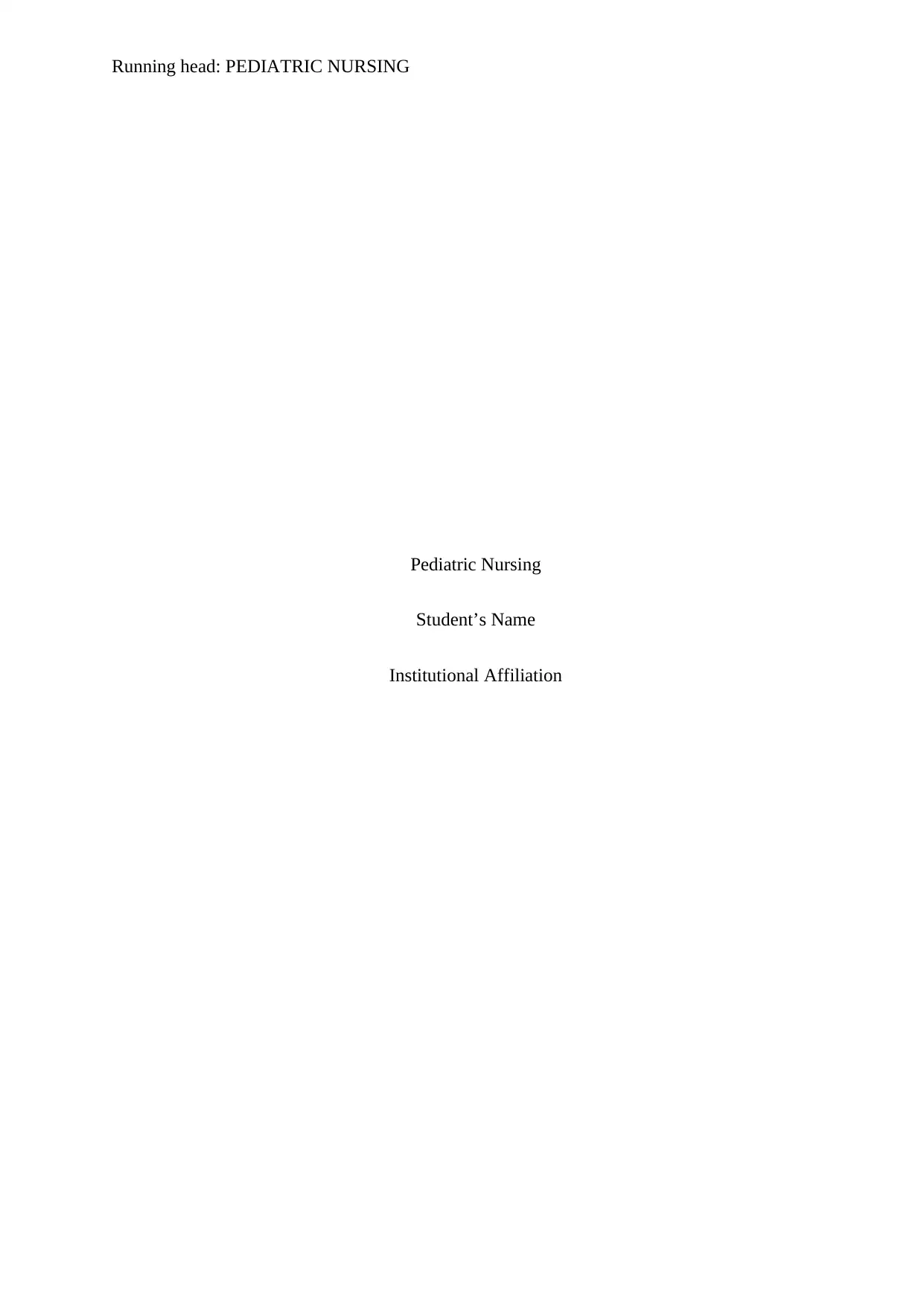
Running head: PEDIATRIC NURSING
Pediatric Nursing
Student’s Name
Institutional Affiliation
Pediatric Nursing
Student’s Name
Institutional Affiliation
Paraphrase This Document
Need a fresh take? Get an instant paraphrase of this document with our AI Paraphraser
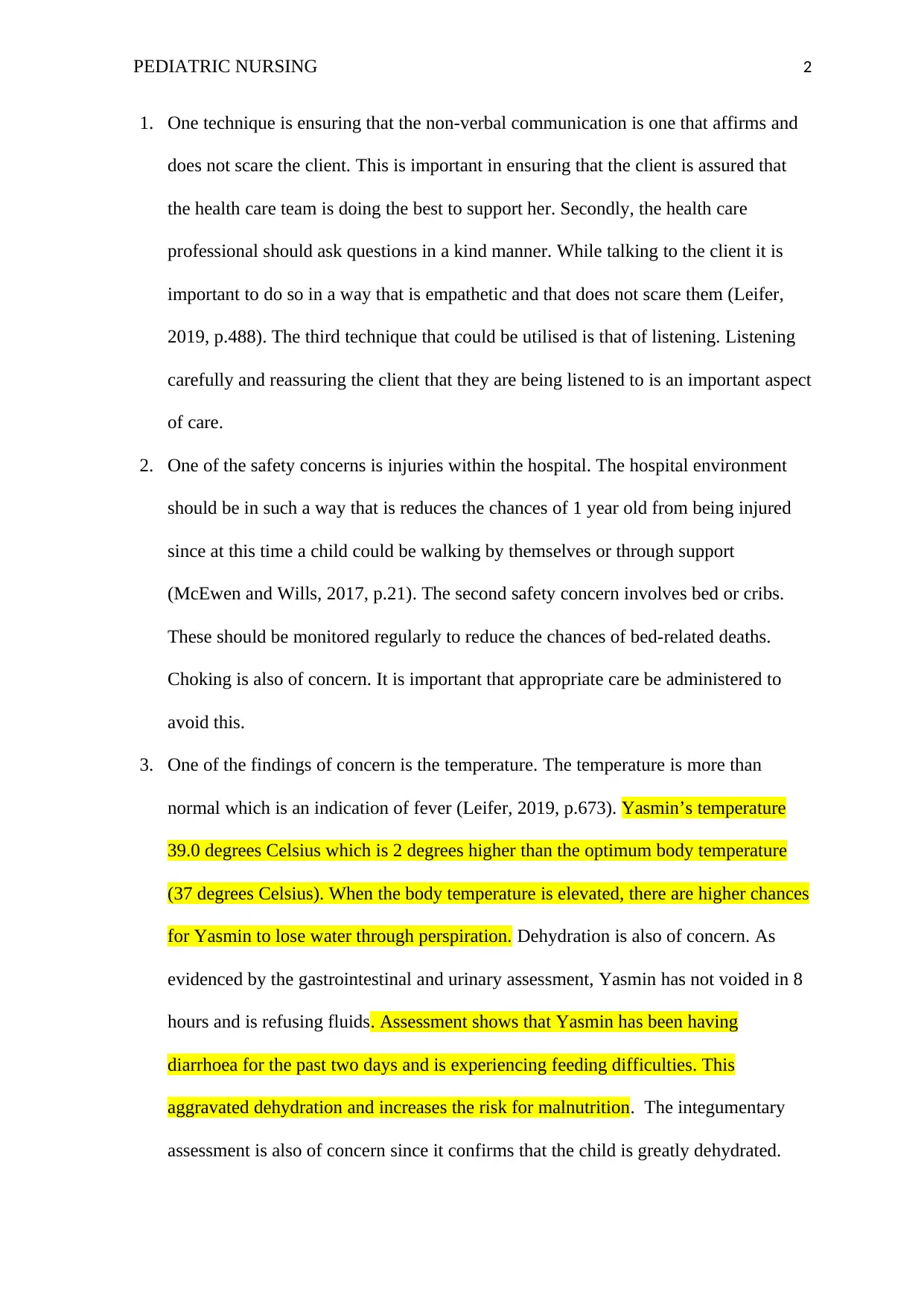
PEDIATRIC NURSING 2
1. One technique is ensuring that the non-verbal communication is one that affirms and
does not scare the client. This is important in ensuring that the client is assured that
the health care team is doing the best to support her. Secondly, the health care
professional should ask questions in a kind manner. While talking to the client it is
important to do so in a way that is empathetic and that does not scare them (Leifer,
2019, p.488). The third technique that could be utilised is that of listening. Listening
carefully and reassuring the client that they are being listened to is an important aspect
of care.
2. One of the safety concerns is injuries within the hospital. The hospital environment
should be in such a way that is reduces the chances of 1 year old from being injured
since at this time a child could be walking by themselves or through support
(McEwen and Wills, 2017, p.21). The second safety concern involves bed or cribs.
These should be monitored regularly to reduce the chances of bed-related deaths.
Choking is also of concern. It is important that appropriate care be administered to
avoid this.
3. One of the findings of concern is the temperature. The temperature is more than
normal which is an indication of fever (Leifer, 2019, p.673). Yasmin’s temperature
39.0 degrees Celsius which is 2 degrees higher than the optimum body temperature
(37 degrees Celsius). When the body temperature is elevated, there are higher chances
for Yasmin to lose water through perspiration. Dehydration is also of concern. As
evidenced by the gastrointestinal and urinary assessment, Yasmin has not voided in 8
hours and is refusing fluids. Assessment shows that Yasmin has been having
diarrhoea for the past two days and is experiencing feeding difficulties. This
aggravated dehydration and increases the risk for malnutrition. The integumentary
assessment is also of concern since it confirms that the child is greatly dehydrated.
1. One technique is ensuring that the non-verbal communication is one that affirms and
does not scare the client. This is important in ensuring that the client is assured that
the health care team is doing the best to support her. Secondly, the health care
professional should ask questions in a kind manner. While talking to the client it is
important to do so in a way that is empathetic and that does not scare them (Leifer,
2019, p.488). The third technique that could be utilised is that of listening. Listening
carefully and reassuring the client that they are being listened to is an important aspect
of care.
2. One of the safety concerns is injuries within the hospital. The hospital environment
should be in such a way that is reduces the chances of 1 year old from being injured
since at this time a child could be walking by themselves or through support
(McEwen and Wills, 2017, p.21). The second safety concern involves bed or cribs.
These should be monitored regularly to reduce the chances of bed-related deaths.
Choking is also of concern. It is important that appropriate care be administered to
avoid this.
3. One of the findings of concern is the temperature. The temperature is more than
normal which is an indication of fever (Leifer, 2019, p.673). Yasmin’s temperature
39.0 degrees Celsius which is 2 degrees higher than the optimum body temperature
(37 degrees Celsius). When the body temperature is elevated, there are higher chances
for Yasmin to lose water through perspiration. Dehydration is also of concern. As
evidenced by the gastrointestinal and urinary assessment, Yasmin has not voided in 8
hours and is refusing fluids. Assessment shows that Yasmin has been having
diarrhoea for the past two days and is experiencing feeding difficulties. This
aggravated dehydration and increases the risk for malnutrition. The integumentary
assessment is also of concern since it confirms that the child is greatly dehydrated.
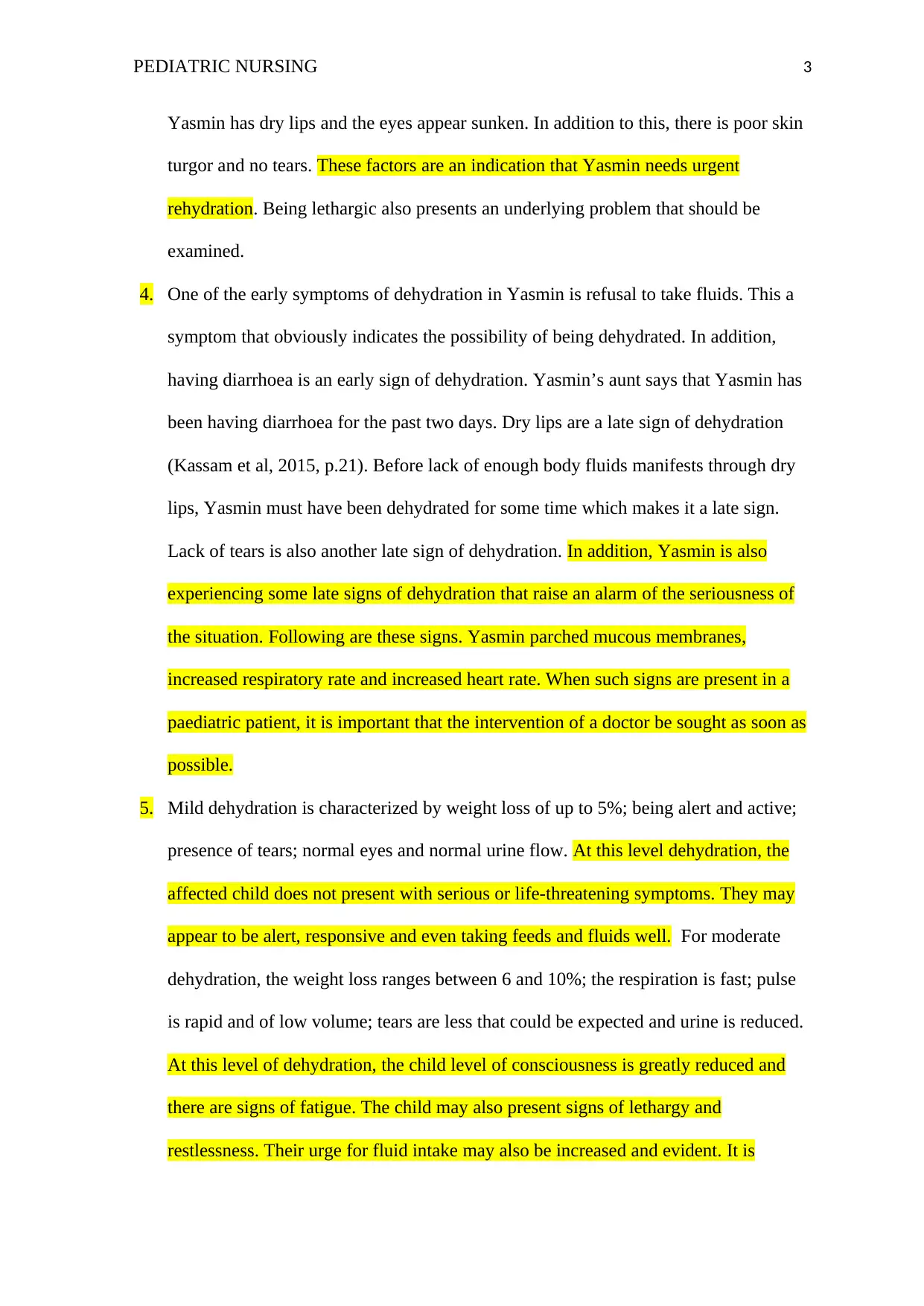
PEDIATRIC NURSING 3
Yasmin has dry lips and the eyes appear sunken. In addition to this, there is poor skin
turgor and no tears. These factors are an indication that Yasmin needs urgent
rehydration. Being lethargic also presents an underlying problem that should be
examined.
4. One of the early symptoms of dehydration in Yasmin is refusal to take fluids. This a
symptom that obviously indicates the possibility of being dehydrated. In addition,
having diarrhoea is an early sign of dehydration. Yasmin’s aunt says that Yasmin has
been having diarrhoea for the past two days. Dry lips are a late sign of dehydration
(Kassam et al, 2015, p.21). Before lack of enough body fluids manifests through dry
lips, Yasmin must have been dehydrated for some time which makes it a late sign.
Lack of tears is also another late sign of dehydration. In addition, Yasmin is also
experiencing some late signs of dehydration that raise an alarm of the seriousness of
the situation. Following are these signs. Yasmin parched mucous membranes,
increased respiratory rate and increased heart rate. When such signs are present in a
paediatric patient, it is important that the intervention of a doctor be sought as soon as
possible.
5. Mild dehydration is characterized by weight loss of up to 5%; being alert and active;
presence of tears; normal eyes and normal urine flow. At this level dehydration, the
affected child does not present with serious or life-threatening symptoms. They may
appear to be alert, responsive and even taking feeds and fluids well. For moderate
dehydration, the weight loss ranges between 6 and 10%; the respiration is fast; pulse
is rapid and of low volume; tears are less that could be expected and urine is reduced.
At this level of dehydration, the child level of consciousness is greatly reduced and
there are signs of fatigue. The child may also present signs of lethargy and
restlessness. Their urge for fluid intake may also be increased and evident. It is
Yasmin has dry lips and the eyes appear sunken. In addition to this, there is poor skin
turgor and no tears. These factors are an indication that Yasmin needs urgent
rehydration. Being lethargic also presents an underlying problem that should be
examined.
4. One of the early symptoms of dehydration in Yasmin is refusal to take fluids. This a
symptom that obviously indicates the possibility of being dehydrated. In addition,
having diarrhoea is an early sign of dehydration. Yasmin’s aunt says that Yasmin has
been having diarrhoea for the past two days. Dry lips are a late sign of dehydration
(Kassam et al, 2015, p.21). Before lack of enough body fluids manifests through dry
lips, Yasmin must have been dehydrated for some time which makes it a late sign.
Lack of tears is also another late sign of dehydration. In addition, Yasmin is also
experiencing some late signs of dehydration that raise an alarm of the seriousness of
the situation. Following are these signs. Yasmin parched mucous membranes,
increased respiratory rate and increased heart rate. When such signs are present in a
paediatric patient, it is important that the intervention of a doctor be sought as soon as
possible.
5. Mild dehydration is characterized by weight loss of up to 5%; being alert and active;
presence of tears; normal eyes and normal urine flow. At this level dehydration, the
affected child does not present with serious or life-threatening symptoms. They may
appear to be alert, responsive and even taking feeds and fluids well. For moderate
dehydration, the weight loss ranges between 6 and 10%; the respiration is fast; pulse
is rapid and of low volume; tears are less that could be expected and urine is reduced.
At this level of dehydration, the child level of consciousness is greatly reduced and
there are signs of fatigue. The child may also present signs of lethargy and
restlessness. Their urge for fluid intake may also be increased and evident. It is
⊘ This is a preview!⊘
Do you want full access?
Subscribe today to unlock all pages.

Trusted by 1+ million students worldwide
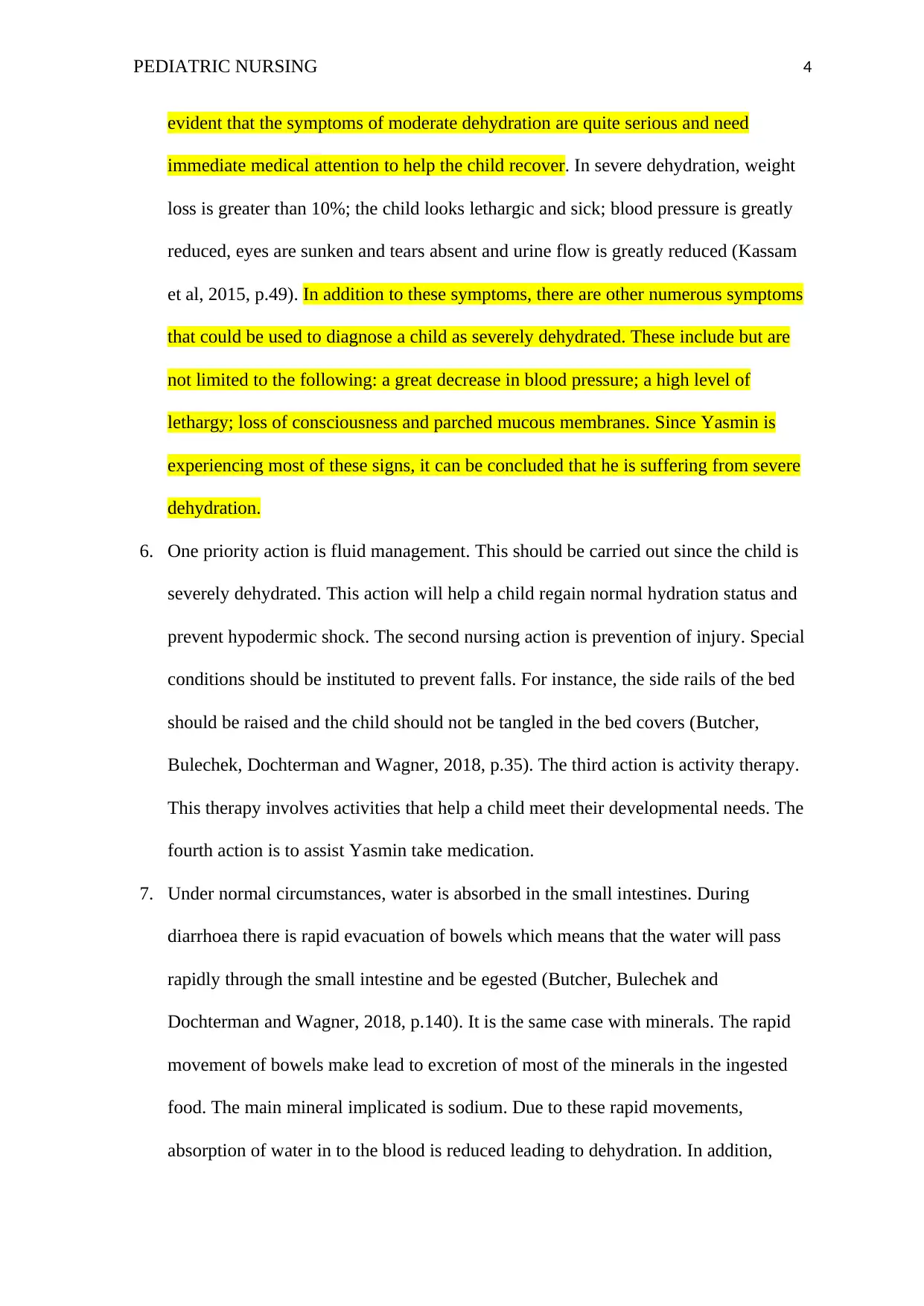
PEDIATRIC NURSING 4
evident that the symptoms of moderate dehydration are quite serious and need
immediate medical attention to help the child recover. In severe dehydration, weight
loss is greater than 10%; the child looks lethargic and sick; blood pressure is greatly
reduced, eyes are sunken and tears absent and urine flow is greatly reduced (Kassam
et al, 2015, p.49). In addition to these symptoms, there are other numerous symptoms
that could be used to diagnose a child as severely dehydrated. These include but are
not limited to the following: a great decrease in blood pressure; a high level of
lethargy; loss of consciousness and parched mucous membranes. Since Yasmin is
experiencing most of these signs, it can be concluded that he is suffering from severe
dehydration.
6. One priority action is fluid management. This should be carried out since the child is
severely dehydrated. This action will help a child regain normal hydration status and
prevent hypodermic shock. The second nursing action is prevention of injury. Special
conditions should be instituted to prevent falls. For instance, the side rails of the bed
should be raised and the child should not be tangled in the bed covers (Butcher,
Bulechek, Dochterman and Wagner, 2018, p.35). The third action is activity therapy.
This therapy involves activities that help a child meet their developmental needs. The
fourth action is to assist Yasmin take medication.
7. Under normal circumstances, water is absorbed in the small intestines. During
diarrhoea there is rapid evacuation of bowels which means that the water will pass
rapidly through the small intestine and be egested (Butcher, Bulechek and
Dochterman and Wagner, 2018, p.140). It is the same case with minerals. The rapid
movement of bowels make lead to excretion of most of the minerals in the ingested
food. The main mineral implicated is sodium. Due to these rapid movements,
absorption of water in to the blood is reduced leading to dehydration. In addition,
evident that the symptoms of moderate dehydration are quite serious and need
immediate medical attention to help the child recover. In severe dehydration, weight
loss is greater than 10%; the child looks lethargic and sick; blood pressure is greatly
reduced, eyes are sunken and tears absent and urine flow is greatly reduced (Kassam
et al, 2015, p.49). In addition to these symptoms, there are other numerous symptoms
that could be used to diagnose a child as severely dehydrated. These include but are
not limited to the following: a great decrease in blood pressure; a high level of
lethargy; loss of consciousness and parched mucous membranes. Since Yasmin is
experiencing most of these signs, it can be concluded that he is suffering from severe
dehydration.
6. One priority action is fluid management. This should be carried out since the child is
severely dehydrated. This action will help a child regain normal hydration status and
prevent hypodermic shock. The second nursing action is prevention of injury. Special
conditions should be instituted to prevent falls. For instance, the side rails of the bed
should be raised and the child should not be tangled in the bed covers (Butcher,
Bulechek, Dochterman and Wagner, 2018, p.35). The third action is activity therapy.
This therapy involves activities that help a child meet their developmental needs. The
fourth action is to assist Yasmin take medication.
7. Under normal circumstances, water is absorbed in the small intestines. During
diarrhoea there is rapid evacuation of bowels which means that the water will pass
rapidly through the small intestine and be egested (Butcher, Bulechek and
Dochterman and Wagner, 2018, p.140). It is the same case with minerals. The rapid
movement of bowels make lead to excretion of most of the minerals in the ingested
food. The main mineral implicated is sodium. Due to these rapid movements,
absorption of water in to the blood is reduced leading to dehydration. In addition,
Paraphrase This Document
Need a fresh take? Get an instant paraphrase of this document with our AI Paraphraser
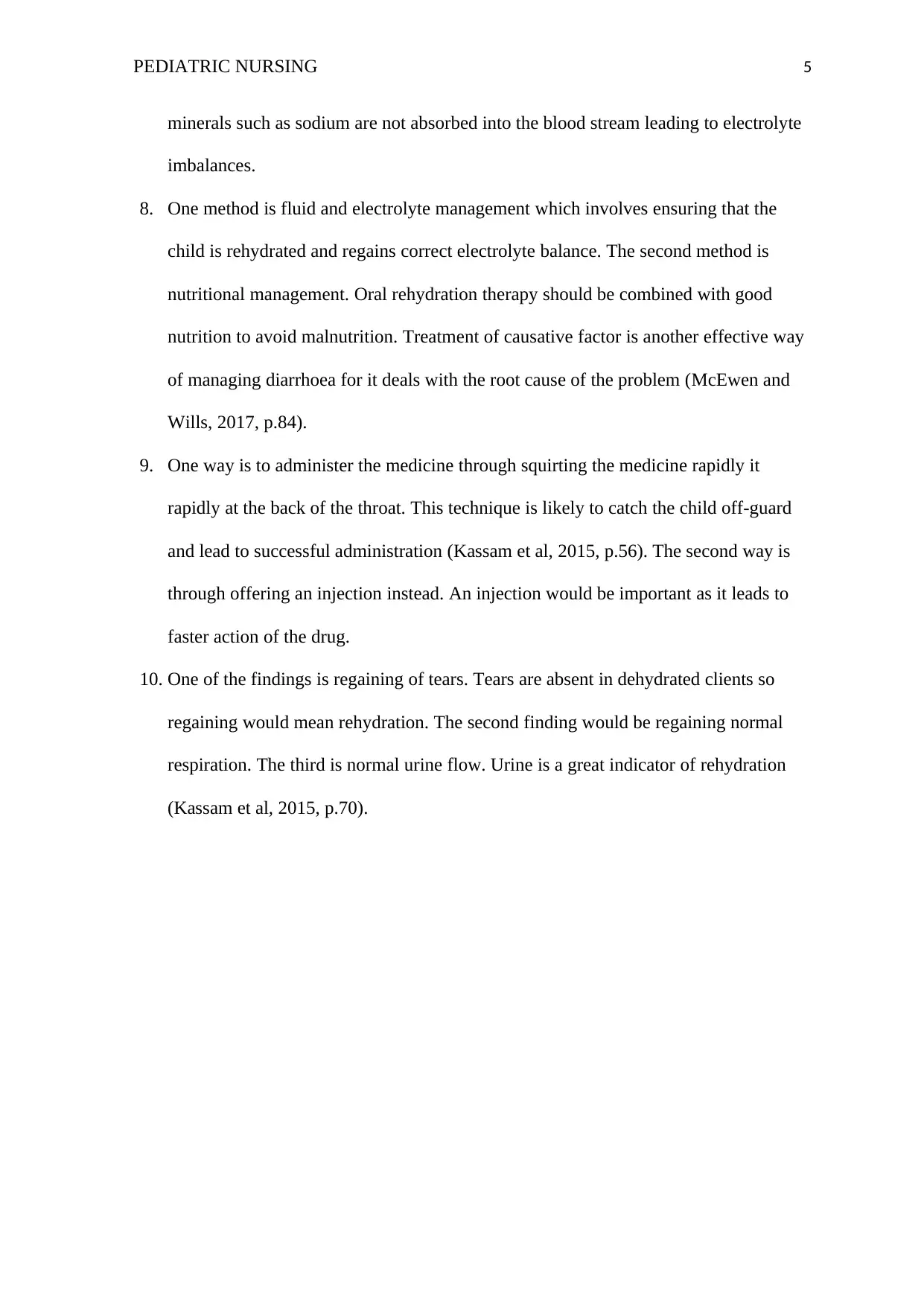
PEDIATRIC NURSING 5
minerals such as sodium are not absorbed into the blood stream leading to electrolyte
imbalances.
8. One method is fluid and electrolyte management which involves ensuring that the
child is rehydrated and regains correct electrolyte balance. The second method is
nutritional management. Oral rehydration therapy should be combined with good
nutrition to avoid malnutrition. Treatment of causative factor is another effective way
of managing diarrhoea for it deals with the root cause of the problem (McEwen and
Wills, 2017, p.84).
9. One way is to administer the medicine through squirting the medicine rapidly it
rapidly at the back of the throat. This technique is likely to catch the child off-guard
and lead to successful administration (Kassam et al, 2015, p.56). The second way is
through offering an injection instead. An injection would be important as it leads to
faster action of the drug.
10. One of the findings is regaining of tears. Tears are absent in dehydrated clients so
regaining would mean rehydration. The second finding would be regaining normal
respiration. The third is normal urine flow. Urine is a great indicator of rehydration
(Kassam et al, 2015, p.70).
minerals such as sodium are not absorbed into the blood stream leading to electrolyte
imbalances.
8. One method is fluid and electrolyte management which involves ensuring that the
child is rehydrated and regains correct electrolyte balance. The second method is
nutritional management. Oral rehydration therapy should be combined with good
nutrition to avoid malnutrition. Treatment of causative factor is another effective way
of managing diarrhoea for it deals with the root cause of the problem (McEwen and
Wills, 2017, p.84).
9. One way is to administer the medicine through squirting the medicine rapidly it
rapidly at the back of the throat. This technique is likely to catch the child off-guard
and lead to successful administration (Kassam et al, 2015, p.56). The second way is
through offering an injection instead. An injection would be important as it leads to
faster action of the drug.
10. One of the findings is regaining of tears. Tears are absent in dehydrated clients so
regaining would mean rehydration. The second finding would be regaining normal
respiration. The third is normal urine flow. Urine is a great indicator of rehydration
(Kassam et al, 2015, p.70).

PEDIATRIC NURSING 6
References
Butcher, H. K., Bulechek, G. M., Dochterman, J. M. M., & Wagner, C. M. (2018). Nursing
Interventions classification (NIC)-E-Book. Elsevier Health Sciences.
Kassam-Adams, N., Rzucidlo, S., Campbell, M., Good, G., Bonifacio, E., Slouf, K. &
Grather, D. (2015). Nurses' views and current practice of trauma-informed pediatric
nursing care. Journal of pediatric nursing, 30(3), 478-484.
Leifer, G. (2019). Introduction to maternity and pediatric nursing. St. Louis, MO: Elsevier.
McEwen, M., & Wills, E. M. (2017). Theoretical basis for nursing. Lippincott Williams &
Wilkins.
References
Butcher, H. K., Bulechek, G. M., Dochterman, J. M. M., & Wagner, C. M. (2018). Nursing
Interventions classification (NIC)-E-Book. Elsevier Health Sciences.
Kassam-Adams, N., Rzucidlo, S., Campbell, M., Good, G., Bonifacio, E., Slouf, K. &
Grather, D. (2015). Nurses' views and current practice of trauma-informed pediatric
nursing care. Journal of pediatric nursing, 30(3), 478-484.
Leifer, G. (2019). Introduction to maternity and pediatric nursing. St. Louis, MO: Elsevier.
McEwen, M., & Wills, E. M. (2017). Theoretical basis for nursing. Lippincott Williams &
Wilkins.
⊘ This is a preview!⊘
Do you want full access?
Subscribe today to unlock all pages.

Trusted by 1+ million students worldwide
1 out of 6
Your All-in-One AI-Powered Toolkit for Academic Success.
+13062052269
info@desklib.com
Available 24*7 on WhatsApp / Email
![[object Object]](/_next/static/media/star-bottom.7253800d.svg)
Unlock your academic potential
Copyright © 2020–2025 A2Z Services. All Rights Reserved. Developed and managed by ZUCOL.

